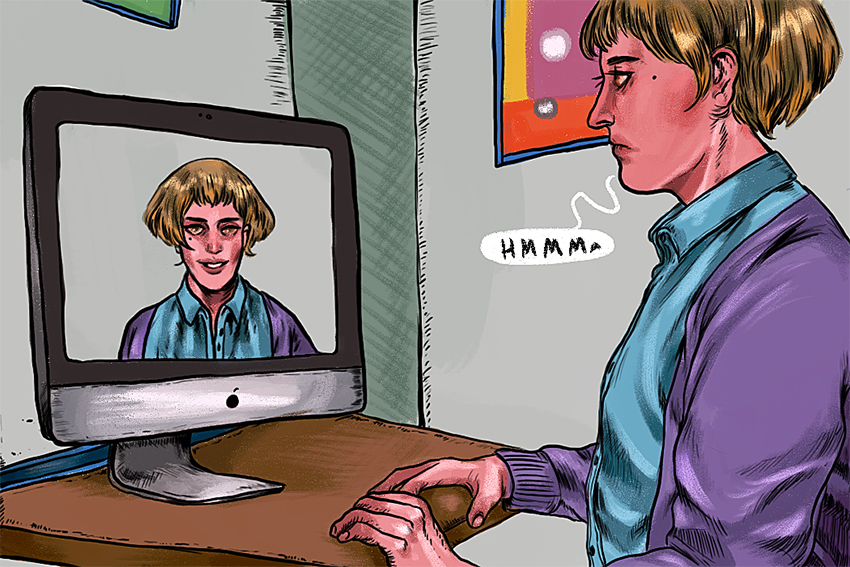UT researcher Brian Korgel plans to build something that’s only been seen in science fiction — technology that will allow the user to feel what others feel.
Korgel, a UT chemical engineer, recently received funding from the National Academies of Sciences, Engineering and Medicine to develop something he calls an empathy mirror.
“The concept of the empathy mirror is to use state-of-the-art technology and create an electronic interface where people can experience how it would feel to be another person,” Korgel said.
Last year, Korgel worked with a team of engineers and scientists from Drexel, Stanford and McGill, as well as a company called Vapor Communications, to develop this idea during meetings held by the National Academy Keck Futures Initiative.
During these meetings, Korgel and his team discussed the ideas that technology is driving people apart and that polarizing beliefs limit human interaction. Korgel said the group concluded people need to empathize more and understand one another better.
“Especially in the election cycle, when you look at Twitter and Facebook and see people saying things like ‘Trump is the devil’ and ‘Hillary should go to jail,’ there is no conversation going on between the two groups of people.” Korgel said. “This is referred to as the echo chamber, where you are just sort of hearing your voice over and over again and not actually discussing things.”
As a solution to this problem, the team decided to design an art exhibition-style device that people could interact with to improve their empathy.
“The idea is that you are looking at a mirror, but the mirror is really a screen or TV that just looks like a mirror,” Korgel said. “You’d basically be looking at your image, a reflection of you, and that reflection will say things back to you that you don’t believe. It could be political things, it could be almost anything. The idea is that if you see yourself saying things that you really don’t agree with, but are potentially debatable, you might react to them.”
The team received $100,000 in April and will use this funding to develop a prototype of the empathy mirror over the next two years.
Korgel said the team has also considered using physical stimuli to activate someone’s senses. The team plans on combining existing technologies, such as different types of sensors that monitor heart rate and breathing, as well as a program that can recreate someone’s voice, and putting them together in a unique way.
Jeff Blum, a team member and electrical engineering postdoctoral student from McGill, said using these physical stimuli can lead to a better understanding of someone’s reactions.
“We believe that a multi-modal experience will have more impact than just, for example, a purely video-based exhibit,” Blum said. “Emotions involve the entire body, so we believe that the empathy mirror should involve multiple senses as well.”
Zora Arnold, a recent radio-television-film graduate who has experience in virtual reality, said that while she might be uneasy about the empathy mirror, she would be willing to try it.
“I think it could change my mind about things,” Arnold said. “I think these technologies have great potential to affect people in an emotional way and we are just getting started with it.”
The team is also focused on making the project a collaboration between art and science, especially in designing the interface of the empathy mirror. Korgel has previously worked with artists and hopes to develop a space on campus where scientists and engineers can collaborate with different creators.
“Artists are makers and are very creative people and a lot of times actually have to invent a machine to do their art,” Korgel said. “They are really well equipped to be part of the research process, but scientists and engineers generally don’t understand that because they don’t always understand what artists do.”
The team anticipates many challenges, including gathering funding for building the device, working with team members and creating a device that can reach the maximum amount of people.
“[The biggest challenge] will be building a system that can work reliably in a public space and reach a large number of people, yet still integrate haptic (touch), olfactory (smell) and visual components to create an experience that people reflect on beyond the time spent in the exhibit itself,” Blum said.
Korgel said the empathy mirror will be open for anyone to use and experience but hopes it can have more specific uses, such as helping children with autism learn more about human emotion. After the prototype is complete, the team will set up a nonprofit and try to raise close to $1 million to actually build the device.
“With so many of us existing in islands of like-minded people, considering other perspectives can be challenging, but I’d argue that doing so is crucial to building a more resilient society,”
Blum said.















